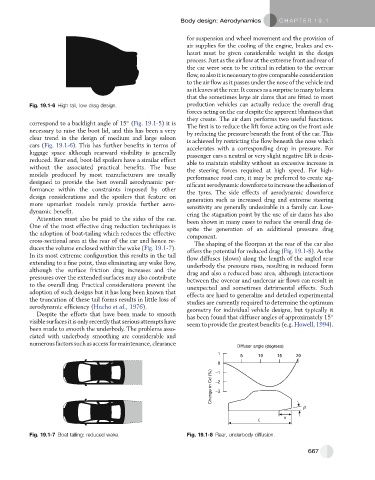Page 657 - Automotive Engineering Powertrain Chassis System and Vehicle Body
P. 657
Body design: Aerodynamics C HAPTER 19.1
for suspension and wheel movement and the provision of
air supplies for the cooling of the engine, brakes and ex-
haust must be given considerable weight in the design
process. Just as the airflow at the extreme front and rear of
the car were seen to be critical in relation to the overcar
flow, so also it is necessary to give comparable consideration
to the air flow as it passes under the nose of the vehicle and
asitleaves atthe rear. It comes asasurpriseto manyto learn
that the sometimes large air dams that are fitted to most
Fig. 19.1-6 High tail, low drag design. production vehicles can actually reduce the overall drag
forces acting on the car despite the apparent bluntness that
they create. The air dam performs two useful functions.
correspond to a backlight angle of 15 (Fig. 19.1-5)itis The first is to reduce the lift force acting on the front axle
necessary to raise the boot lid, and this has been a very by reducing the pressure beneath the front of the car. This
clear trend in the design of medium and large saloon is achieved by restricting the flow beneath the nose which
cars (Fig. 19.1-6). This has further benefits in terms of accelerates with a corresponding drop in pressure. For
luggage space although rearward visibility is generally passenger cars a neutral or very slight negative lift is desir-
reduced. Rear end, boot-lid spoilers have a similar effect able to maintain stability without an excessive increase in
without the associated practical benefits. The base the steering forces required at high speed. For high-
models produced by most manufacturers are usually performance road cars, it may be preferred to create sig-
designed to provide the best overall aerodynamic per- nificantaerodynamicdownforceto increase theadhesionof
formance within the constraints imposed by other the tyres. The side effects of aerodynamic downforce
design considerations and the spoilers that feature on generation such as increased drag and extreme steering
more upmarket models rarely provide further aero- sensitivity are generally undesirable in a family car. Low-
dynamic benefit. ering the stagnation point by the use of air dams has also
Attention must also be paid to the sides of the car. been shown in many cases to reduce the overall drag de-
One of the most effective drag reduction techniques is spite the generation of an additional pressure drag
the adoption of boat-tailing which reduces the effective component.
cross-sectional area at the rear of the car and hence re-
The shaping of the floorpan at the rear of the car also
duces the volume enclosed within the wake (Fig. 19.1-7).
offers the potential for reduced drag (Fig. 19.1-8). As the
In its most extreme configuration this results in the tail
flow diffuses (slows) along the length of the angled rear
extending to a fine point, thus eliminating any wake flow,
underbody the pressure rises, resulting in reduced form
although the surface friction drag increases and the
drag and also a reduced base area, although interactions
pressures over the extended surfaces may also contribute between the overcar and undercar air flows can result in
to the overall drag. Practical considerations prevent the unexpected and sometimes detrimental effects. Such
adoption of such designs but it has long been known that effects are hard to generalize and detailed experimental
the truncation of these tail forms results in little loss of studies are currently required to determine the optimum
aerodynamic efficiency (Hucho et al., 1976). geometry for individual vehicle designs, but typically it
Despite the efforts that have been made to smooth has been found that diffuser angles of approximately 15
visiblesurfacesit is only recentlythatseriousattempts have seem to provide the greatest benefits (e.g. Howell, 1994).
been made to smooth the underbody. The problems asso-
ciated with underbody smoothing are considerable and
numerous factors such as access for maintenance, clearance
Diffuser angle (degrees)
1
5 10 15 20
0
Change in Cd (%) –2
–1
–3
β
x
L
Fig. 19.1-7 Boat tailing: reduced wake. Fig. 19.1-8 Rear, underbody diffusion.
667

